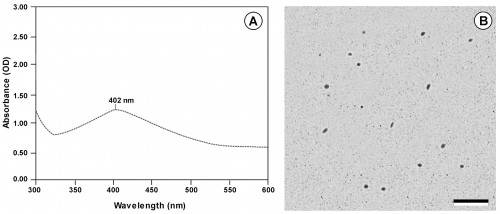Tropical Plant Research
An International Journal by Society for Tropical Plant Research
2019, VOLUME 6 ISSUE 2Pages: 293-298
Biogenic fabrication, characterization, and assessment of antibacterial activity of silver nanoparticles of a high altitude Himalayan lichen - Cladonia rangiferina (L.) Weber ex F.H. Wigg.
Himanshu Rai* and Rajan Kumar Gupta
*Centre of Advanced Study in Botany, Institute of Science, Banaras Hindu University, Varanasi-221005, Uttar Pradesh, India
Abstract:
Silver nanoparticles synthesized using plant metabolites provide an edge over chemically synthesized compounds due to their comparatively efficient antimicrobial activity. In the present study, AgNPs was prepared by bioreduction of silver nitrate (AgNO3) using the aqueous extract of Cladonia rangiferina collected ≥3500 m in Uttarkashi district of Uttarakhand, western Himalaya. The formation of Ag NPs was indicated by yellow-brown color after 72 h. The AgNPs were characterized by UV-Vis spectrophotometry, Fourier transformed infrared (FTIR) spectroscopy, scanning electron spectroscopy (SEM) analysis. Ag-NPs thus obtained were tested for antimicrobial activity against selected gram-negative (i.e. Escherichia coli, Klebsiella pneuomoniae, and Pseudomonas aeruginosa) and gram-positive (i.e. Bacillus subtilis, Staphylococcus aureus, and Staphylococcus epidermidis) bacterial strains employing Bauer-Kirby’s disk diffusion assay using Gentamicin as positive control and distil water as negative control. The bioreduction of AgNO3 yielded stable spherical and rod-shaped Ag-NPs showing characteristic UV-Vis spectral band peak with specific color change. The FTIR showed the role of many functional groups of different organic lichen secondary metabolites in AgNPs fabrication and stabilization. The synthesized AgNPs showed enhanced activity to positive control (i.e. Gentamicin). The study highlighted that lichen AgNPs can be used as better antibacterial material.
Silver nanoparticles synthesized using plant metabolites provide an edge over chemically synthesized compounds due to their comparatively efficient antimicrobial activity. In the present study, AgNPs was prepared by bioreduction of silver nitrate (AgNO3) using the aqueous extract of Cladonia rangiferina collected ≥3500 m in Uttarkashi district of Uttarakhand, western Himalaya. The formation of Ag NPs was indicated by yellow-brown color after 72 h. The AgNPs were characterized by UV-Vis spectrophotometry, Fourier transformed infrared (FTIR) spectroscopy, scanning electron spectroscopy (SEM) analysis. Ag-NPs thus obtained were tested for antimicrobial activity against selected gram-negative (i.e. Escherichia coli, Klebsiella pneuomoniae, and Pseudomonas aeruginosa) and gram-positive (i.e. Bacillus subtilis, Staphylococcus aureus, and Staphylococcus epidermidis) bacterial strains employing Bauer-Kirby’s disk diffusion assay using Gentamicin as positive control and distil water as negative control. The bioreduction of AgNO3 yielded stable spherical and rod-shaped Ag-NPs showing characteristic UV-Vis spectral band peak with specific color change. The FTIR showed the role of many functional groups of different organic lichen secondary metabolites in AgNPs fabrication and stabilization. The synthesized AgNPs showed enhanced activity to positive control (i.e. Gentamicin). The study highlighted that lichen AgNPs can be used as better antibacterial material.

Fig.: A, UV-Vis absorption spectrum of AgNPs synthesized using the aqueous extract of Cladonia rangiferina (L.) Weber ex F.H. Wigg.; B, TEM image of Cladonia rangiferina-AgNPs obtained after 72 h of the reduction reaction, (Scale = 1 μm).
| 0 | 1 | 2 | 5 | 6 | 3 | 4 | 0 |


